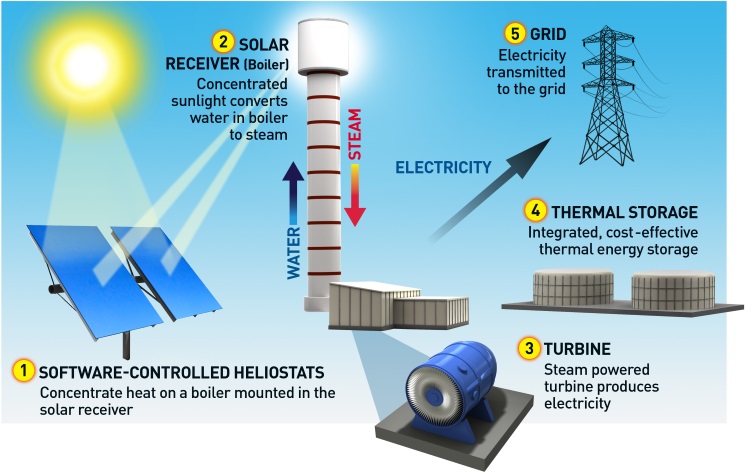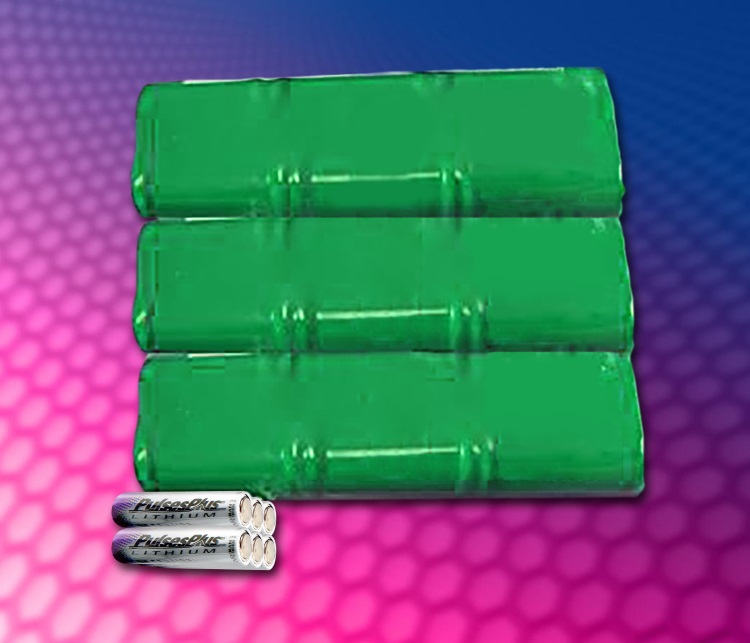The use of energy-harvesting technology in tandem with rechargeable Li-ion batteries is creating an exciting growth trajectory that spans virtually every industrial category. These dynamic growth opportunities will accelerate even further with the emergence of the Industrial Internet of Things (IIoT).
For potential applications to be deemed suitable for energy harvesting, there must be a reliable source of renewable energy, including the sun, vibration, temperature variations, and RF/EM signals. While once relegated to applications requiring microamps of energy, the emergence of the IIoT forces us to rethink the use of energy-harvesting technology on a much broader scale because virtually every external environment will soon become fertile ground for deploying remote wireless devices.
Let’s examine one particular real-life example that has important implications for many other industrial applications.
Powering heliostats to deliver concentrated solar electricity
A prime example of industrial-grade energy harvesting being applied to deliver cost-effective energy to power remote wireless devices is the Ashalim Solar Thermal Power Station, which is being constructed by BrightSource Energy in Israel’s Negev Desert. This facility will use concentrated solar power (CSP) to supply 121 MW of renewable energy — enough to meet the daily needs of more than 120,000 households. Scheduled for completion in 2017, the Ashalim power station will help fulfill Israel’s national commitment to use renewable energy sources to supply more than 10% of the country’s total electricity needs by 2020.
The Ashalim power station will feature 50,000 sun-tracking mirrors, or heliostats, that direct concentrated sunlight toward a solar receiver/boiler located atop a tower. When concentrated sunlight strikes the receiver/boiler, it heats a transfer fluid that is circulated to produce enough superheated steam (540°C) to power steam turbines (see Fig. 1 ).

Fig. 1: A typical example of concentrated solar power (CSP).
A key advantage of CSP technology is that it allows thermal energy to be stored, enabling electricity to be produced as needed any time of day. CSP technology requires approximately five to 10 acres of land per megawatt of capacity, but higher efficiencies can be achieved if the system generates 100 MW or more.
The 50,000 heliostat mirrors at the Ashalim power plant will measure 4 x 5.2 m, with the rotation and tilt of each mirror being controlled by a dual-axis tracking system capable of 360° positioning, fully networked to ensure maximum concentration of energy. Each heliostat motor will be energized by a small battery pack using six TLI series AA-size industrial-grade rechargeable Li-ion batteries that store energy harvested from small photovoltaic panels attached to each heliostat. These industrial-grade batteries will deliver the high pulses (5 A for a AA-sized cell) required for two-way wireless communications and system control and data acquisition (SCADA) functionality while also powering the servo motors that continually reposition the heliostats.
The Ashalim project will feature the innovative use of wireless communications technology to network all 50,000 heliostats, thus eliminating the need for miles of expensive cabling and wiring and saving 85% of the installation costs associated with previous wireless networking solutions. This economical approach will also serve to accelerate the construction schedule while improving long-term system reliability.
Industrial grade Li-ion batteries required
Because the Negev Desert is such an extreme environment, consumer-grade Li-ion rechargeable batteries were clearly unsuited for this particular application. Mainly designed for powering cell phones and laptops, consumer-grade Li-ion cells have major drawbacks for industrial-grade applications, including a short life expectancy (less than five years), a low maximum-cycle life (500 full recharge cycles), high annual self-discharge (up to 60% per year), a limited temperature range (0°C to 60°C), and the inability to deliver high pulses.
The use of industrial-grade Li-ion batteries made economic sense for the Ashalim power plant because they can operate for up to 20 years and 5,000 full recharge cycles without battery replacement. Extended battery life serves to lower the total cost of ownership, as having to change-out 50,000 consumer-grade batteries every five years would be an enormously costly and time-consuming endeavor, far exceeding any initial savings achieved by specifying inexpensive consumer-grade Li-ion batteries.
Industrial-grade Li-ion cells also feature an extended temperature range (–40°C to 85°C) and a precision-welded hermetic seal, whereas consumer-grade batteries use crimped seals that may leak.
Comparing Li-ion batteries to supercapacitors
There are numerous reasons why BrightSource selected industrial-grade Li-ion batteries over bulkier supercapacitors for the Ashalim power plant. Supercapacitors (also known as ultra-capacitors or electric double-layer capacitors) store energy in an electrostatic field rather than in a chemical state. Supercapacitors feature very high capacitance, which is ideal for memory backup in mobile phones, laptops, digital cameras, and other consumer devices. However, to store more energy, supercapacitors need to integrate an electrolyte and a very thin insulator that is often made of cardboard or paper. As a result, these supercapacitors can only deliver low voltage, as higher-voltage requirements would cause the electrolyte to break down. Other drawbacks include short duration power, linear discharge characteristics that do not allow for the use of all the available energy, low capacity, very high self-discharge (often exceeding 60% per year), and the need for cell balancing when multiple supercapacitors are linked in series.
As Fig. 2 demonstrates, supercapacitors can be much bulkier than comparable industrial-grade Li-ion batteries, as three large packs of supercapacitors consisting of six D-size cells each (or 18 cells total) were replaced by a much smaller battery pack consisting of six AA-size TLI Series rechargeable Li-ion batteries.

Fig. 2: A small pack of six AA-size TLI Series Li-ion rechargeable batteries can replace three larger packs consisting of six D-size supercapacitors each, or 18 cells in total.
In addition to reducing size and weight, the industrial-grade Li-ion battery pack offers other performance advantages over an equivalent supercapacitor solution, including:
- Higher practical capacity: The equivalent pseudo-capacitance is 1,200 F, whereas a supercapacitor having the same volume has about 10 F of maximum capacitance (3.6 V).
- Lower self-discharge: 1 to 2 μA of self-discharge current compared to 20 to 50 μA of discharge current for a supercapacitor having the same external volume. Self-discharge is the normal voltage drop experienced over time when a cell is not subjected to a load.
- Stable voltage: Li-ion batteries deliver fairly constant voltage as they are discharged, while supercapacitors experience a severe drop in voltage as they discharge stored energy.
- Higher number of cycles: AA-size Li-ion cells can be charged and discharged for 5,000 cycles between 2.8 V and 3.9 V (80% depth of discharge).
- Significantly higher cell voltage than a supercapacitor, able to deliver the high pulses needed to power two-way communications for system control.
Translation to other industrial applications
The use of energy harvesting in conjunction with industrial-grade Li-ion batteries will reach far beyond the power-generation industry to encompass a wide range of remote wireless sensor applications tied to the burgeoning IIoT. Industrial-grade Li-ion batteries are generally preferred over consumer batteries for devices that are deployed in highly remote locations and extreme environments, and where large-scale battery change-outs could prove highly cost-prohibitive.
Advertisement
Learn more about Tadiran





